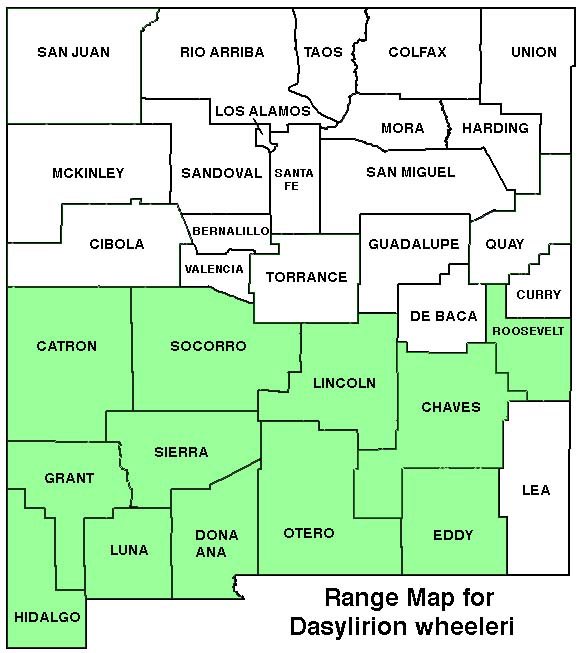WILDFLOWERS OF NEW MEXICO

Related to yuccas and agaves, this distinctive desert plant has a dense rosette of 3-foot long, linear leaves lined with vicious, forward-pointing spines. Over time a short trunk, usually covered with a sheath of dead leaves, develops. Note the 15-foot woody flower stalk is lined with little clusters of small, creamy flowers. Male (pollen producing) and female (seed producing) plants are separate. Called “desert spoon” because the leaf base is spoon-shaped.
FLOWER: May–July. A rapidly growing bloom stalk emerges from the middle of the dense rosette of spiny leaves and reaches up to 15 feet tall in about 3 weeks. Clusters of small, white flowers cover the upper half. Male flowers are tassel-like with copious amounts of pollen; female flowers develop dense clusters of golden-brown fruit capsules. Numerous hole-nesting bees and beetles drill tunnels in the woody bloom stalk and lay their eggs. Plants don’t bloom every year.
LEAVES: Dense basal rosette 4–6 feet tall and wide, develops hundreds of leaves. Blades gray-green, linear, 14–40 inches long (35–100 cm) to 1 1/4 inches wide (3 cm); margins lined with sharp, forward-pointing spines; tips dry, brown.
HABITAT: Dry gravelly, sandy soils; rocky slopes, foothills, desert plains; desert grasslands and scrub, juniper-mesquite woodlands.
ELEVATION: 4,000–6,500 feet.
RANGE: AZ, NM; Mexico. Widely used as a landscape plant outside its native range.
SIMILAR SPECIES: The more southern D. leiophyllum, occurring in Dona Ana, Luna, and Eddy counties and the Trans-Pecos, Texas, looks identical but has backward-pointing spines.
NM COUNTIES: Southern half of NM in low- to mid-elevation, dry habitats: Catron, Chaves, Dona Ana, Eddy, Grant, Hidalgo, Lincoln, Luna, Otero, Roosevelt, Sierra, Socorro.









SOTOL, DESERT SPOON
DASYLIRION WHEELERI
Asparagus Family, Asparagaceae (Beargrass Family, Nolinaceae)
Evergreen subshrub



























THE CONTENTS OF THIS WEBSITE ARE COPYRIGHTED AND CANNOT BE USED
WITHOUT PERMISSION OF GEORGE OXFORD MILLER
















EMAIL ME









Organ Mountains
The flower stalk emerges from the 3–5 foot tall and wide basal rosette of spiny leaves and takes about 3 weeks to reach 15 feet tall.









Bees swarm around the pollen-rich male flowers.
Female flowers produce numerous seed capsules.


















Sharp forward-facing spines line the long, leathery leaves of the rosette.









Sotols thrive on rocky foothill slopes in desert grasslands and scrub vegetation at mid-elevations.
















